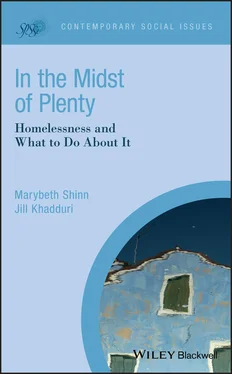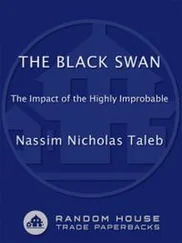We did two things to estimate the undercount. First, we planted people masquerading as homeless in locations where we knew counters were assigned to see whether they were counted. (If so the plant gave a sticker to the counting team for its tally sheet, to be sure that the plants were not confused with people actually experiencing homelessness.) By all accounts, the counters accepted finding the plants as a challenge that motivated them to be more thorough. Beth was one such plant: I shivered in a torn coat on the lower level of the Union Square subway station near New York University where I taught at the time, hoping that none of my students would come by, but also hoping the counters would find me so I could go somewhere warmer before my tour of duty ended at 4 a.m. The counters nabbed me and, overall, 71% of the plants. In most cases that were missed, the counters never showed up. Occasionally there was confusion over boundaries (did the counters' park zone include the bench between the park wall and the street?). Additionally, counters gave more or less plausible reasons (an apparent tryst or undercover stakeout) why they assumed someone was not homeless and did not ask.
Second, we visited soup kitchens, mobile food programs, drop‐in centers and the like over the next 2 days, and asked people where they had been on the night of the count. If they were homeless and not in shelter, we asked follow‐up questions to ascertain whether they could have been counted, if counters sent to their location had done exactly what they were instructed to do. For example, if people said they were on the subway, we asked whether they went to the end of the line, where counters moved onto cars to interview people who did not get off. Only 70% of people were in places where they could plausibly have been counted. Others—on a rooftop, in an abandoned building or a stairwell of an occupied one, in a parking structure, or on a porch behind shrubbery were not visible to teams walking the streets.
To be included in the street count, a person had both to be in a visible place (as all the plants were) and to be counted. Thus the proportions from the two stages of our study multiply—suggesting that about half of the people who were sleeping rough that night were missed, although that estimate is not precise. Further, people were more likely to be found if they were in Manhattan, where most buildings are flush with sidewalks and most alleys are walled off, than in outer boroughs, where the varied streetscapes provide more hidden places. The rest of the country looks more like the outer boroughs than like Manhattan, suggesting that street counts elsewhere probably miss more. For example, in the huge geography that constitutes the Los Angeles metropolitan area, many people who sleep under freeways and in other dispersed locations probably are missed.
Unsheltered people who are found during the PIT count are added to the numbers in shelters and transitional housing programs that night. New York's overall PIT count is also better than those of many other cities, because people have a legal right to shelter. So a much larger proportion of homeless people in New York stay in facilities where the count is essentially perfect. However, people who are not found, or who are unsheltered on a different night would not be included in the PIT count, although they may appear in annual numbers if they also use shelter during the course of the year.
Despite their shortcomings, the most detailed national information on the characteristics of people who experience literal homelessness come from these two sources—the administrative data in Homeless Management Information Systems and the one‐night, PIT counts. The latter are less detailed, because it is hard to ask people a lot of questions about themselves when counting them in unsheltered locations in the middle of the night. What do these data sources tell us?
Groups of People Who Experience Literal Homelessness
The starting point for classifying people who experience homelessness is to distinguish adults and children who experience homelessness together (“families”) from people who experience homelessness without an accompanying child (“individuals”). This distinction is made by the U.S. Department of HUD in its annual reports to Congress, by the U.S. Interagency Council on Homelessness in federal strategic plans to end homelessness, and by community‐level planners who are responsible for allocating federal and local resources to address homelessness. The distinction between families and individuals is based loosely on the research literature that began to describe modern homelessness in the late 1980s, as well as the arrangements localities made for shelters, especially in the eastern part of the U.S. It has proved useful for policy and practice. Other groupings (veterans, youth, and people with chronic patterns of homelessness) overlap with both families and individuals.
Nationally, on any given night, close to half (46%) of all people experiencing homelessness in shelters are members of families staying in shelters together (Henry, Mahathey, et al., 2018). In contrast, only a third (34%) of people in shelters at some time over the course of a year are in families (Henry, Bishop, et al., 2018; Henry, Mahathey, et al., 2018). Because families stay in shelters for longer periods of time than individuals, they are more likely to be found in shelters on any particular night. Expanding the definition of homelessness beyond literal homelessness—for example, using the Department of Education's definition that includes doubling up—could make the proportion of people with insecure housing that are in families with children rather than individuals even higher. But there is no count of people without children who meet the Department of Education definition, so we really don't know. 6
More than 290,000 children under the age of 18 used shelters with their families at some time during the most recent year for which we have data (Henry, Bishop, et al., 2018, p. 3.9). Few children show up in the unsheltered counts (only available for a single night), as adults rarely take a child with them to an unsheltered location (Henry, Mahathey, et al., 2018, pp. 1–3 and exhibit 4.1). However, homelessness affects many more families with minor children than the data on people using shelters or found on the streets imply. Many people in shelters for single adults are in fact parents of minor children from whom they have been separated, and the same may be true of people experiencing unsheltered homelessness. In one large national study of people experiencing homelessness conducted in 1996, 47% of the people surveyed reported that they had minor children, but only 15% had a child with them during the episode of homelessness. One third of mothers were separated from all of their minor children (Burt et al., 1999).
In the more recent Family Options Study, a large experiment that enrolled 2,282 families with children 15 or under from 57 homeless shelters in 12 sites, 7 all families had a child with them, but 24% also had a minor child living elsewhere. The vast majority of these separations were informal; less than 1% of respondents reported that a child was in foster care. Over a quarter of families (27%) were headed by a couple, with both partners together in the shelter, but another 10% had a spouse or partner somewhere else (Gubits et al., 2015; Walton, Dunton, & Groves, 2017).
The separation of families is the first example of several we will cite about how demographic and other characteristics of people who are observed during an episode of homelessness may reflect the experience of homelessness and the programs communities use to address it. In in‐depth interviews with a subsample of 80 families in the Family Options Study, some parents reported separating from some children to spare them from shelter conditions (often after they had entered shelter together) although they most often described economic hardship as the reason for the separation, like this mother interviewed in Alameda County, California:
Читать дальше












